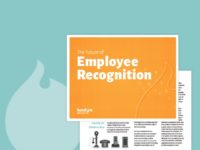Introducing a new employee rewards and recognition program is a significant moment for any enterprise.
Recognition is a key driver of the ever-elusive employee engagement and great workplace culture. Among employed Americans, 40% say they’d put more energy into their work if they were recognized more often—and that’s not hot air. Organizations with recognition programs outperform those without them by an average of 14% in areas of employee engagement, customer service, and productivity. And organizations that are particularly effective at raising engagement scores through recognition see 31% lower turnover.
In order to change the low engagement levels across enterprises nationwide, leaders must scrutinize and refine their employee rewards and recognition practices.
The working world has gone through dramatic changes in recent years, and employee recognition (and what makes it successful) is changing along with it. The future of recognition is less focused on physical rewards; instead, driven more by moments of micro-recognition promoted by everyone (not just leaders) across an organization. But the pace of change is such that we can no longer deploy point solutions and expect them to meet our needs in perpetuity. Even if an organization were to implement a program that accommodates these needs today, future changes could render that program obsolete in just a few short years.
Related White Paper: How to Adapt Your Recognition Program for the Future
Adapting for the future means understanding that recognition, like everything else, will continue to undergo change. And that change will only be coming quicker and quicker. For a program to truly be successful, leaders need to look at recognition as an investment, not an expense. It will require continual evaluation and modification to remain effective and meet our future needs.
Here’s a few suggestions to reduce risk and increase the success of your employee rewards and recognition program:
1. Feedback is fundamental
A survey at a recent conference gathering HR professionals across the nation showed that 39% of this population used employee feedback to measure the effectiveness of recognition. Feedback is especially valuable as programs evolve and require employees to become more active participants and drivers of recognition. Stevens Sainte-Rose, CHRO of Walgreens, has a notable approach to feedback that leverages multiple mediums, ensuring employees can use their preferred communications channels. When Sainte-Rose was first appointed to his role, he wasn’t content to lead without the input of his employees. In fact, as he initiated a series of projects designed to make the culture more “purpose-driven,” he leveraged employee feedback quite a bit.
Sainte-Rose set up a multi-channel system that ensured employees had every avenue possible to make their voices heard: social media, blogs, corporate advising boards, even in-store listening sessions. Your organization may not warrant a listening system of that magnitude—few organizations operate at the scale of Walgreens. Tailor your feedback solution to the size of your company. Make it as comprehensive as possible by ensuring employees have multiple avenues to provide feedback.
2. Leverage leadership teams
Leaders have a profound influence on the sustainability of a recognition program, and the effects of recognition itself. An estimated 28% of organizations that do not offer recognition programs cite a lack of support from senior leadership as the primary reason for this shortcoming. What’s particularly troubling about this information is how it reveals that these performance-driving programs are being stymied by the very population that makes them work the best. Gallup has found recognition is most effective when it comes from managers, high-level leaders, and even CEOs.
Put simply, even though peer-driven recognition is on the rise, a culture of recognition is not possible without leaders leading by example. Thankfully, the remedy for this is simple—recognize early, recognize often. Leaders can set the tenor for a new, recognition-rich culture by making habitual use of the formal recognition program and practicing more informal, spontaneous micro-recognition. This is as easy as dedicating brief moments in company gatherings to recognizing employees and celebrating small wins. Be frequent, be social, and most of all, be appreciative.
3. Communicate, communicate, communicate
Just as communication cannot be one-sided, it also cannot be one-and-done. So long as there is a program in place at your company, the “conversation” around recognition can never end. Employees need to understand how to use their recognition system, the behaviors that are rewarded, and why they are important. SHRM estimates the average annual U.S. turnover rate is 19%. In generalized terms, that means potentially one-fifth of your employees could leave the company within the year. If communication is one-and-done, the new hires replacing those employees won’t understand the behaviors that make your program successful.
More often than not, recognition programs fail because leaders will invest in technology with no planning for the education and long-term sustainability the program needs. You can combat this by executing a communications strategy built on a model of shared responsibility. Divvy up responsibility across HR, senior leaders and management, and culture champions to communicate the ins and outs of your recognition program. Define specific roles and responsibilities that make it clear everyone is a stakeholder in the program’s success. Then, leverage every channel at your disposal—not just static mediums like newsletters and fliers—to communicate to your employees. Keep them abreast on everything including how to interact with the program, any changes you make to the program, and the behaviors that merit recognition in the first place (and why they’re valuable). Speaking of which…
4. Expand the scope of what you recognize
Historically, employee recognition has had a narrow focus in three categories of award: length of employee service, retirement commendations, and outperforming company benchmarks. But the average person’s work experience encompasses so much more than time-served and output produced. Notably, there’s debate over whether retirement and service awards are even effective. Bersin by Deloitte found that tenure based awards had no effect on organizational performance.
Instead of looking at recognition through the narrow lens of these three categories, expand the scope of what the company deems praiseworthy—remember this is about the employee’s emotional state of mind and many factors of the employee experience can have an impact. Acknowledge behaviors tied to company culture and values, champion team wins, knowledge sharing, innovation, learning, collaboration—all of these behaviors contribute to moments like when the sales team brings in a record amount of revenue, or when the customer service department earns high marks in customer satisfaction. Outcomes are important, there’s no discounting that. But the intermediary behaviors that lead to those outcomes are just as important.
5. Use an Agile methodology
As you set out to make changes to your program, keep your head above the water with short sprints for development. Your employee feedback, as well as data you pull from the program itself, will help guide your decision-making process and tell you what changes to make first. Always assume that some part of your plan is wrong and can be improved. Build a recognition program that is always looking to improve its impact.
Traditional workflow approaches follow a Waterfall model—information flows in a linear fashion from one stage of development to the next. Although waterfall can be thorough, inclusive and give everyone a feeling of less risk—it is not well suited for an era where “disruption” and change is our reality. The accelerating pace of societal change means Waterfall models risk delivering you solutions misaligned with your present and future needs.
A less risky approach with a tangible impact will follow more of an Agile model. Agile processes involve short cycles of development, punctuated by periods of reassessment and reprioritization. In these review periods, consulting feedback and program data will help you determine how to adjust future sprints to meet your benchmarks.
Our future is not one where leaders can afford to be incurious about employee rewards and recognition. Never stop evaluating the effectiveness of your employee rewards and recognition tools. What are the goals of your program, and have they shifted since you first adopted it? How are your employees responding to recognition? What part of the process can you improve? These questions will help guide you through recognition’s future, and the roadmap laid above.


 5 min
5 min




